Smart Factory Market Size
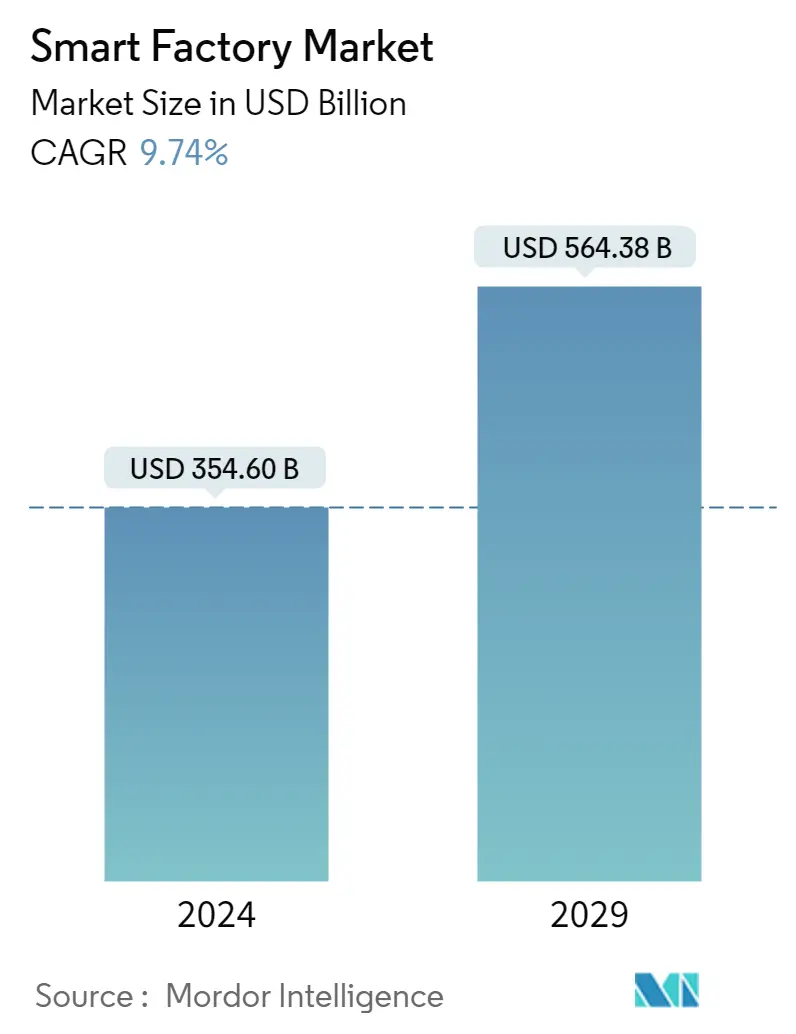
| Study Period | 2019 - 2029 |
| Market Size (2024) | USD 354.60 Billion |
| Market Size (2029) | USD 564.38 Billion |
| CAGR (2024 - 2029) | 9.74 % |
| Fastest Growing Market | Asia Pacific |
| Largest Market | Asia-Pacific |
Major Players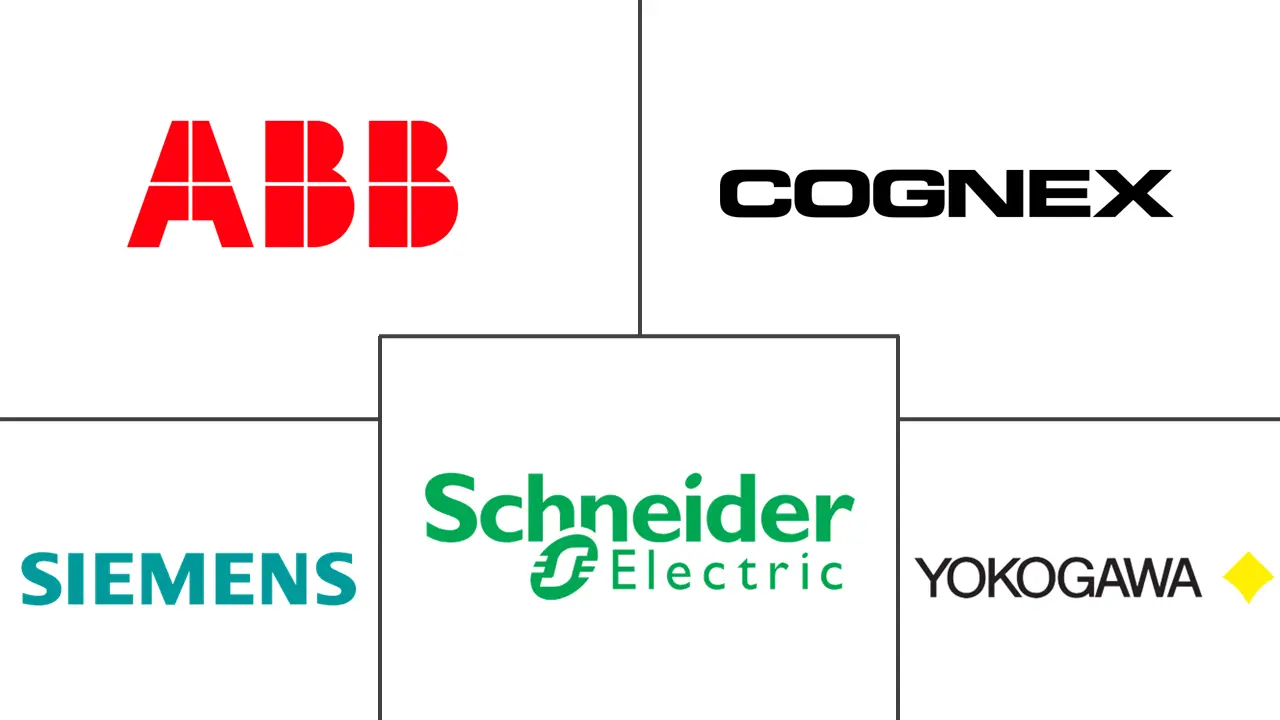
*Disclaimer: Major Players sorted in no particular order |
Smart Factory Market Analysis
The Smart Factory Market size is estimated at USD 354.60 billion in 2024, and is expected to reach USD 564.38 billion by 2029, growing at a CAGR of 9.74% during the forecast period (2024-2029).
- Tremendous shifts in manufacturing due to Industry 4.0 and the approval of IoT require enterprises to adopt agile, more innovative, and creative ways to advance production with technologies that complement and augment human labor with automation and reduce industrial accidents caused by process failure. With the increased rate of adoption of connected devices and sensors and the fostering of M2M communication, a surge in the data points that are developed in the manufacturing industry is being observed.
- According to Zebra’s Manufacturing Vision Study, smart asset-tracking solutions based on IoT and RFID overtook traditional, spreadsheet-based methods in 2022. Maryville University calculates that by 2025, more than 180 trillion gigabytes of data are anticipated to be created worldwide yearly. IIoT-enabled industries will generate a large portion of this. In addition, an Industrial IoT (IIoT) company Microsoft Corporation survey found that 85 percent of companies have at least one IIoT use case project. This number increased, as approx 95 percent of respondents implemented IIoT strategies in 2022.
- Incremental advancement in technology, coupled with a sustained increase in the development of manufacturing facilities, is expected to impact the market growth rate during the forecast period. For instance, Intel has recently partnered with Telecom Italia and hardware manufacturer Exor International to develop a smart manufacturing facility that uses artificial intelligence (AI) and 5G networking.
- Furthermore, the glowing market penetration of AI and machine learning (ML) technologies may enhance the accuracy and speed of data analysis, thereby significantly driving the market forward. Moreover, the advancement in the field devices market, robots, and sensors may further expand the scope of the studied market. According to Cisco projections, by 2022, machine-to-machine (M2M) connections that support IoT applications may have accounted for more than 50 percent of the world's 28.5 billion connected devices. Many governments also motivate manufacturing companies to invest in IoT technologies for smart factory adoption, which creates a favorable outlook for the growth of the studied market.
- However, a high installation cost is the primary factor challenging the market's growth. Additionally, the requirement of a highly skilled workforce to operate and maintain the automation infrastructure further adds to the overall cost, restraining mass adoption, especially in small and medium-scale industries.
- Additionally, the recent economic instability, especially as an outcome of the pandemic and geo-political issues such as the US-China trade dispute and the Russia-Ukraine war, is also challenging the studied market's growth as it has not only led to an uncertain business environment across various regions but are also impacting the supply chain of industrial sectors and demand for manufactured products across various region, leading to an unfavorable environment for the studied market's growth.
Smart Factory Market Trends
Semiconductor Sector is Expected to Drive the Market Growth
- Semiconductor manufacturers rely on smart manufacturing processes to produce higher yields and margins. By advancing semiconductor innovation and encouraging the further implementation of innovative technologies powered by advanced chips, manufacturers can ensure that production keeps pace with rising demand as factories become more complex and connected.
- Semiconductor fabrication plants, or fabs, cost billions of dollars to build and maintain. The cost goes on equipment, the maintenance of which is vital to ongoing operation. By using innovative manufacturing technologies to observe equipment health and execute predictive maintenance, fabs can decrease unplanned maintenance time significantly.
- The semiconductor fabrication plants globally are on the rise. Also, the Semiconductor Industry Association reported increased spending on new semiconductor equipment. These factors will also drive the adoption of smart factories in the semiconductor industry. According to the Semiconductor Industry Association (SIA), in 2022, semiconductor sales reached USD 580.13 billion worldwide. Semiconductors are crucial components of electronic devices, and the industry is highly competitive. The year-on-year growth rate in 2022 reached 4.4 percent. Additionally, semiconductor sales in Europe in March 2022 were USD 4.63 billion, up slightly from last month's figures, which recorded USD 4.51 billion.
- Moreover, various countries in this region are focused on encouraging semiconductor manufacturing through government policies offering tax breaks, money, subsidies, and other forms of assistance. For instance, according to the government, the Indian semiconductor sector was valued at USD 15 billion in 2020 and is anticipated to grow to USD 63 billion by 2026 (Source: Ministry of Electronics & IT). Through governmental intervention in the manufacturing of semiconductors and the peripheral sector, India is expected to become one of the leading countries in global semiconductor supply chains.
- In addition, in September 2022, mining conglomerate Vedanta and Taiwanese electronics manufacturing giant Foxconn made one of the largest ever investments of USD 1,860 million to set up India's first semiconductor plant in Gujarat. Such investment may further create significant demand in the studied Market.
- Besides, the semiconductor industry is growing to accommodate the rising demand for semiconductor materials in AI-driven electronics and programs such as autonomous vehicles and IoT. The growth in the consumption of electronic components utilized in the navigation of automobiles, safety, and infotainment solutions intention again contribute to the semiconductor industry's growth.
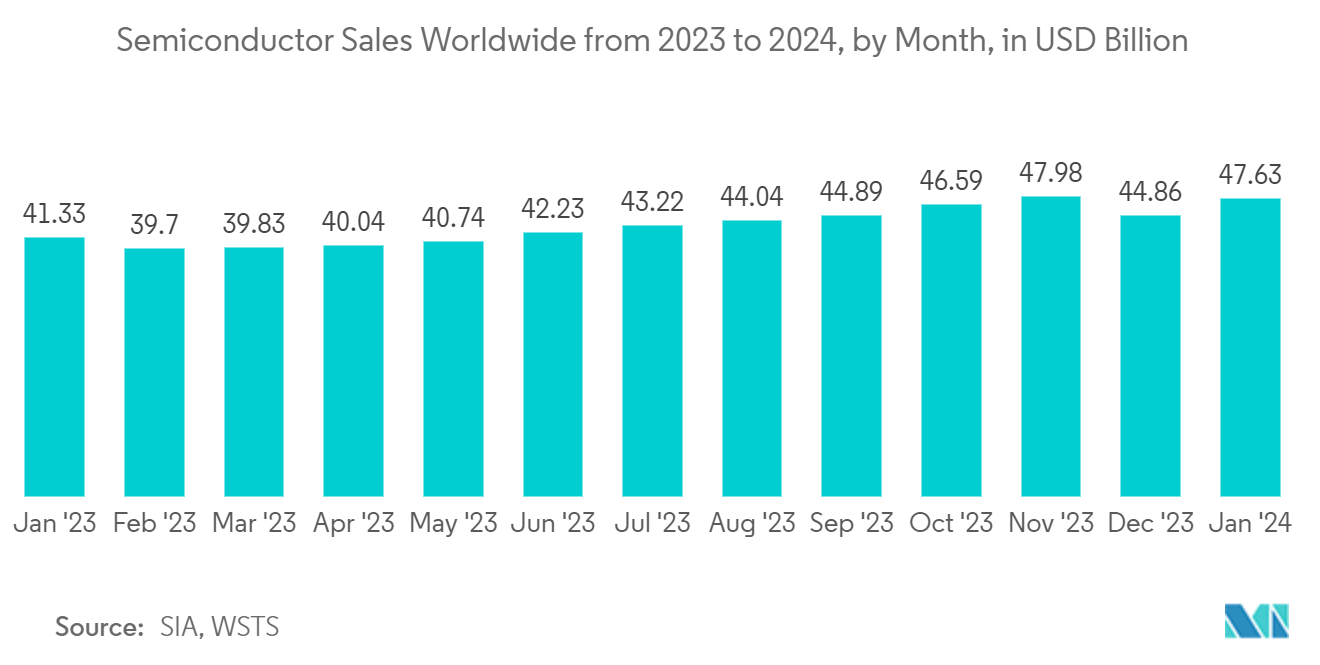
Asia-Pacific to Experience Significant Market Growth
- Asia-Pacific significantly invests in the studied Market. Governments continuously take the initiative to enhance smart manufacturing and technology adoptions in various countries. In addition, the National Manufacturing Policy of the Government of India aims to improve the share of manufacturing in GDP to 25 percent by 2025. Also, the "Make in India" policy of the Government of India is anticipated to increase the demand and consumption of machinery and tools by the local manufacturing industry.
- Moreover, in January 2022, Reliance invested USD 132 million in Addverb Technologies to acquire a 54 percent stake. Such investments in the Market are expected to fuel the adoption of automation in the manufacturing industry, thereby fueling the smart factory market during the forecast period.
- China is an integral part of Asia's rising shift to intelligent applications. The Chinese government has strengthened the design of smart manufacturing by implementing various schemes and demonstrations in developing standard systems. China aims to create 40 manufacturing innovations by 2025. The focus areas include automated machine tools and robotics, new advanced information technology, aerospace and aeronautical equipment, marine equipment, modern rail transport equipment, high-tech shipping, new-energy vehicles and equipment, power equipment, agricultural equipment, new materials, biopharma, and advanced medical products.
- Further, in January 2022, ABB, an automation expert, and HASCO, China's most significant automotive components supplier, announced the construction of a joint venture to push China's automotive industry's next generation of smart production. The joint venture will build on the two businesses' successful partnership, resulting in the vital development of highly flexible and sustainable car parts production within HASCO's China operations.
- Furthermore, Japan is rapidly moving toward "Society 5.0", thus introducing the fifth chapter to the four major stages of human development in this new ultra-smart society. All things are connected through IoT technology, and all technologies are getting integrated, dramatically improving the quality of life. Further, the Japanese government announced connected industries in response to the German government's "Industry 4.0" program, and the momentum for a new manufacturing revolution is rising.
- Further, Korea's commercial and public sectors have agreed to boost the number of local smart factories, intending to have more than 30,000 of them working with the newest digital and analytical technology by 2022. Korea's Ministry of Trade, Industry, and Energy (MOTIE) has reaffirmed the government's ambitions to assist small and medium-sized businesses in adopting and expanding smart manufacturing technology. Small and medium-sized firms (SMEs) account for more than 99 percent of all companies in Korea, and government data suggests that SMEs' exports are growing.
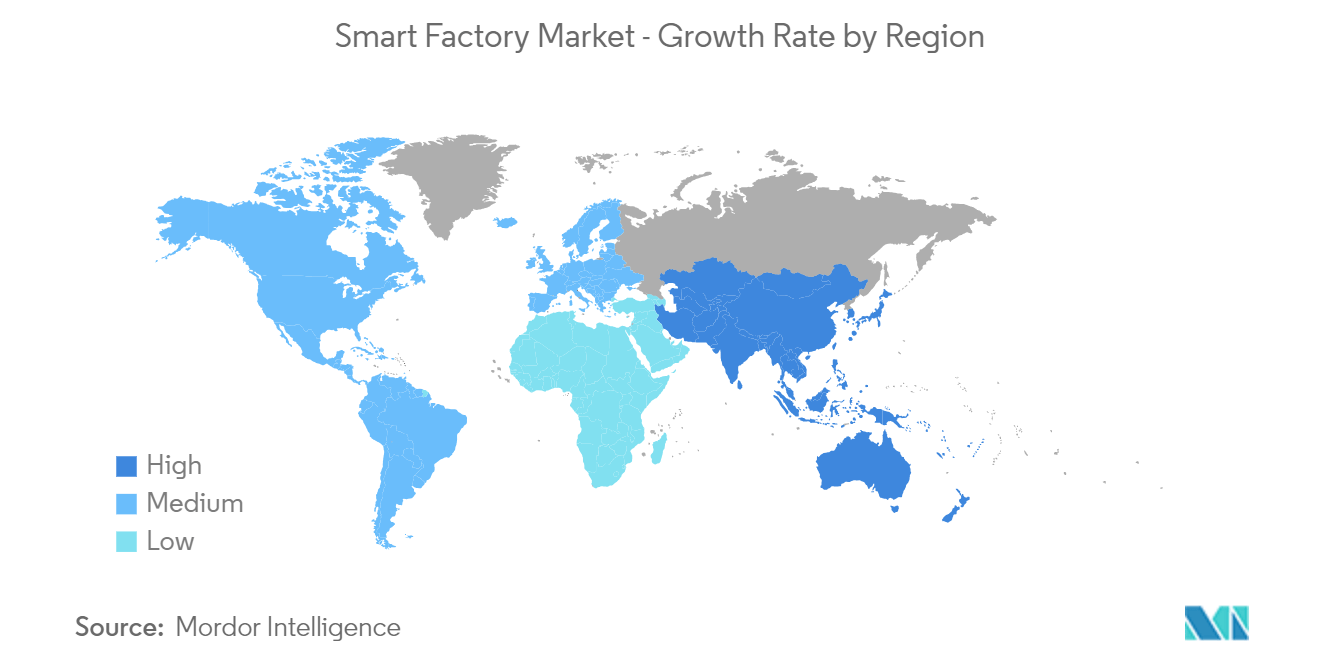
Smart Factory Industry Overview
The smart factory market is fragmented, with significant players like ABB Ltd, Cognex Corporation, Siemens AG, Schneider Electric SE, and Yokogawa Electric Corporation. Players in the market are adopting strategies such as innovations, partnerships, mergers, and acquisitions to improve their product offerings and achieve sustainable competitive advantage.
In March 2023, Schneider Electric, a solution provider for the digital transformation of industrial automation and energy management, broke ground on its new smart factory in Hungary. With an expected investment of EUR 40 million (USD 43 million), the new site will span 25,000 m2 with a headcount of about 500 employees.
In March 2023, Samsung Electronics, a leading consumer electronic device manufacturer, announced its plans to increase investment in setting up smart manufacturing capabilities at its mobile phone manufacturing plant in Noida. The company also announced its plans to expand its research and development facility in the country to make production more competitive and localized.
Smart Factory Market Leaders
-
ABB Ltd
-
Cognex Corporation
-
Siemens AG
-
Schneider Electric SE
-
Yokogawa Electric Corporation
*Disclaimer: Major Players sorted in no particular order
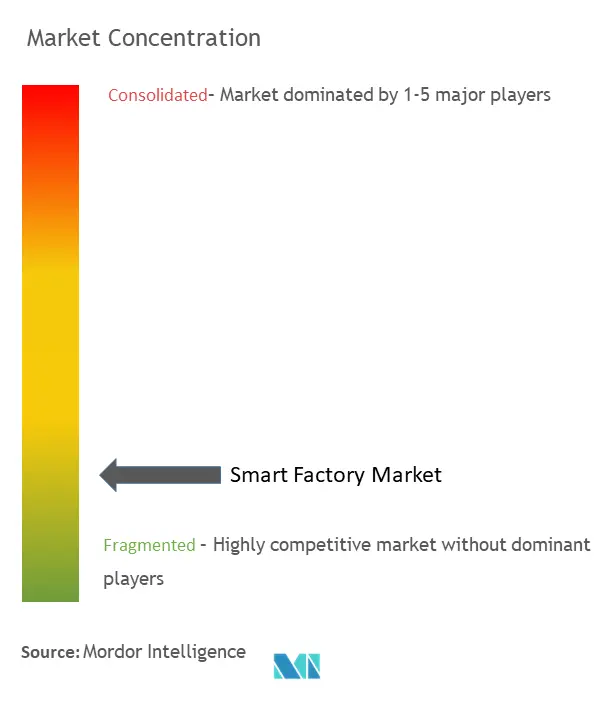
Smart Factory Market News
- February 2023: Emerson combined its extensive power expertise and renewable energy capabilities into the OvationTM Green portfolio to help power generation companies meet the needs of their customers as they transition to green energy generation and storage. Emerson has broadened its power-based control architecture by integrating newly acquired Mita-Teknik software and technology with its industry-leading Ovation automation platform, extensive renewable energy knowledge base, cybersecurity solutions, and remote management capabilities.
- January 2023: Siemens Digital Industries Software announced the launch of eXplore live at Wichita's The Smart Factory. The smart factory contains a fully experiential lab and an active product line for developing and exploring innovative smart manufacturing capabilities. The Siemens Xcelerator portfolio is used in eXplore Live at Deloitte's The Smart Factory in Wichita to help companies experience the power of digitalization and the future of smart manufacturing.
- October 2022: ABB entered into a strategic collaboration with U.S.-based startup Scalable Robotics to improve its portfolio of user-friendly robotic welding techniques. Through 3D vision and implanted process understanding, the Scalable Robotics technology enables users to quickly program welding robots without coding.
Smart Factory Market Report - Table of Contents
1. INTRODUCTION
- 1.1 Study Assumptions and Market Definition
- 1.2 Scope of the Study
2. RESEARCH METHODOLOGY
3. EXECUTIVE SUMMARY
4. MARKET INSIGHTS
- 4.1 Market Overview
-
4.2 Industry Attractiveness - Porter's Five Forces Analysis
- 4.2.1 Bargaining Power of Suppliers
- 4.2.2 Bargaining Power of Buyers
- 4.2.3 Threat of New Entrants
- 4.2.4 Threat of Substitute Products
- 4.2.5 Intensity of Competition
- 4.3 Industry Value Chain Analysis
- 4.4 Assessment of Impact of Macroeconomic Trends on the Market
5. MARKET DYNAMICS
-
5.1 Market Drivers
- 5.1.1 Growing Adoption of Internet of Things (IoT) Technologies Across the Value Chain
- 5.1.2 Rising Demand for Energy Efficiency
-
5.2 Market Restraints
- 5.2.1 Huge Capital Investments for Transformations
- 5.2.2 Vulnerable to Cyberattacks
6. MARKET SEGMENTATION
-
6.1 By Product Type
- 6.1.1 Machine Vision Systems
- 6.1.1.1 Cameras
- 6.1.1.2 Processors
- 6.1.1.3 Software
- 6.1.1.4 Enclosures
- 6.1.1.5 Frame Grabbers
- 6.1.1.6 Integration Services
- 6.1.1.7 Lighting
- 6.1.2 Industrial Robotics
- 6.1.2.1 Articulated Robots
- 6.1.2.2 Cartesian Robots
- 6.1.2.3 Cylindrical Robots
- 6.1.2.4 SCARA Robots
- 6.1.2.5 Parallel Robots
- 6.1.2.6 Collaborative Industry Robots
- 6.1.3 Control Devices
- 6.1.3.1 Relays and Switches
- 6.1.3.2 Servo Motors and Drives
- 6.1.4 Sensors
- 6.1.5 Communication Technologies
- 6.1.5.1 Wired
- 6.1.5.2 Wireless
- 6.1.6 Other Product Types
-
6.2 By Technology
- 6.2.1 Product Lifecycle Management (PLM)
- 6.2.2 Human Machine Interface (HMI)
- 6.2.3 Enterprise Resource and Planning (ERP)
- 6.2.4 Manufacturing Execution System (MES)
- 6.2.5 Distributed Control System (DCS)
- 6.2.6 Supervisory Controller and Data Acquisition (SCADA)
- 6.2.7 Programmable Logic Controller (PLC)
- 6.2.8 Other Technologies
-
6.3 By End-user Industry
- 6.3.1 Automotive
- 6.3.2 Semiconductors
- 6.3.3 Oil and Gas
- 6.3.4 Chemical and Petrochemical
- 6.3.5 Pharmaceutical
- 6.3.6 Aerospace and Defense
- 6.3.7 Food and Beverage
- 6.3.8 Mining
- 6.3.9 Other End-user Industries
-
6.4 By Geography
- 6.4.1 North America
- 6.4.1.1 United States
- 6.4.1.2 Canada
- 6.4.2 Europe
- 6.4.2.1 United Kingdom
- 6.4.2.2 Germany
- 6.4.2.3 France
- 6.4.3 Asia
- 6.4.3.1 China
- 6.4.3.2 India
- 6.4.3.3 Japan
- 6.4.3.4 Australia and New Zealand
- 6.4.4 Latin America
- 6.4.4.1 Brazil
- 6.4.4.2 Argentina
- 6.4.4.3 Mexico
- 6.4.5 Middle East and Africa
- 6.4.5.1 United Arab Emirates
- 6.4.5.2 Saudi Arabia
- 6.4.5.3 South Africa
7. COMPETITIVE LANDSCAPE
-
7.1 Company Profiles
- 7.1.1 ABB Ltd
- 7.1.2 Cognex Corporation
- 7.1.3 Siemens AG
- 7.1.4 Schneider Electric SE
- 7.1.5 Yokogawa Electric Corporation
- 7.1.6 KUKA AG
- 7.1.7 Rockwell Automation Inc.
- 7.1.8 Honeywell International Inc.
- 7.1.9 Robert Bosch GmbH
- 7.1.10 Mitsubishi Electric Corporation
- 7.1.11 Fanuc Corporation
- 7.1.12 Emerson Electric Co.
- 7.1.13 FLIR Systems Inc. (Teledyne Technologies Incorporated)
- *List Not Exhaustive
8. INVESTMENT ANALYSIS
9. FUTURE OF THE MARKET
** Subject To AvailablitySmart Factory Industry Segmentation
Smart factory refers to the different fully integrated automation solutions adopted for manufacturing buildings. Such integration helps streamline the material flow during all the procedures involved in manufacturing. Big Data analytics allows factories to use smart solutions in their functions within its premises to shift from reactionary practices to predictive ones. This change targets enhanced efficiency of the process and product performance.
The studied market is segmented by different product types, such as machine vision systems, industrial robotics, control devices, sensors, and communication technologies, among other technologies. The study also considers various end-user industries and multiple geographies. The impact of macroeconomic trends on the market and impacted segments is also covered under the scope of the study. Further, the disturbance of the factors affecting the market's evolution in the near future has been covered in the study concerning drivers and restraints.
The market sizes and forecasts regarding value in (USD) for all the above segments are provided.
| By Product Type | Machine Vision Systems | Cameras |
| Processors | ||
| Software | ||
| Enclosures | ||
| Frame Grabbers | ||
| Integration Services | ||
| Lighting | ||
| By Product Type | Industrial Robotics | Articulated Robots |
| Cartesian Robots | ||
| Cylindrical Robots | ||
| SCARA Robots | ||
| Parallel Robots | ||
| Collaborative Industry Robots | ||
| By Product Type | Control Devices | Relays and Switches |
| Servo Motors and Drives | ||
| By Product Type | Sensors | |
| Communication Technologies | Wired | |
| Wireless | ||
| Other Product Types | ||
| By Technology | Product Lifecycle Management (PLM) | |
| Human Machine Interface (HMI) | ||
| Enterprise Resource and Planning (ERP) | ||
| Manufacturing Execution System (MES) | ||
| Distributed Control System (DCS) | ||
| Supervisory Controller and Data Acquisition (SCADA) | ||
| Programmable Logic Controller (PLC) | ||
| Other Technologies | ||
| By End-user Industry | Automotive | |
| Semiconductors | ||
| Oil and Gas | ||
| Chemical and Petrochemical | ||
| Pharmaceutical | ||
| Aerospace and Defense | ||
| Food and Beverage | ||
| Mining | ||
| Other End-user Industries | ||
| By Geography | North America | United States |
| Canada | ||
| By Geography | Europe | United Kingdom |
| Germany | ||
| France | ||
| By Geography | Asia | China |
| India | ||
| Japan | ||
| Australia and New Zealand | ||
| By Geography | Latin America | Brazil |
| Argentina | ||
| Mexico | ||
| By Geography | Middle East and Africa | United Arab Emirates |
| Saudi Arabia | ||
| South Africa |
Smart Factory Market Research Faqs
How big is the Smart Factory Market?
The Smart Factory Market size is expected to reach USD 354.60 billion in 2024 and grow at a CAGR of 9.74% to reach USD 564.38 billion by 2029.
What is the current Smart Factory Market size?
In 2024, the Smart Factory Market size is expected to reach USD 354.60 billion.
Who are the key players in Smart Factory Market?
ABB Ltd, Cognex Corporation, Siemens AG, Schneider Electric SE and Yokogawa Electric Corporation are the major companies operating in the Smart Factory Market.
Which is the fastest growing region in Smart Factory Market?
Asia Pacific is estimated to grow at the highest CAGR over the forecast period (2024-2029).
Which region has the biggest share in Smart Factory Market?
In 2024, the Asia-Pacific accounts for the largest market share in Smart Factory Market.
What years does this Smart Factory Market cover, and what was the market size in 2023?
In 2023, the Smart Factory Market size was estimated at USD 320.06 billion. The report covers the Smart Factory Market historical market size for years: 2019, 2020, 2021, 2022 and 2023. The report also forecasts the Smart Factory Market size for years: 2024, 2025, 2026, 2027, 2028 and 2029.
Smart Factory Industry Report
Statistics for the 2024 Smart Factory market share, size and revenue growth rate, created by Mordor Intelligence™ Industry Reports. Smart Factory analysis includes a market forecast outlook to for 2024 to 2029 and historical overview. Get a sample of this industry analysis as a free report PDF download.



